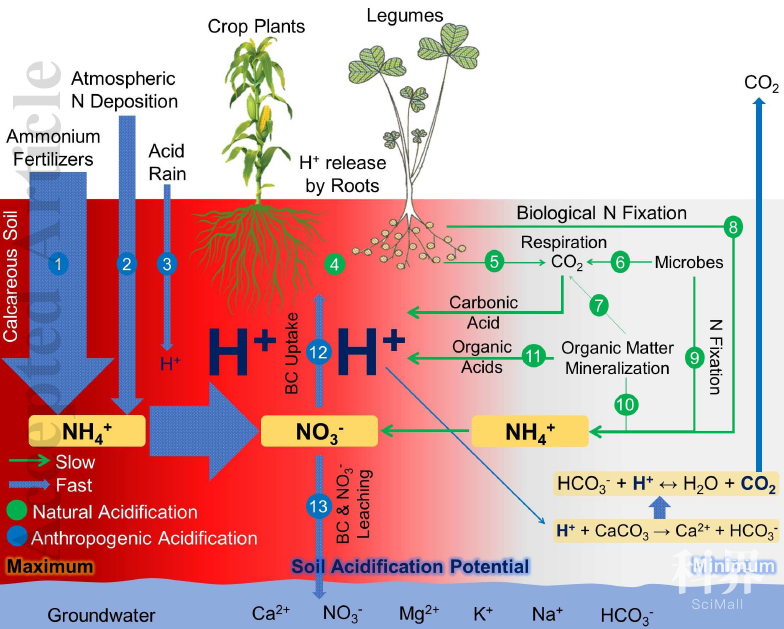科技工作者之家
科界APP是专注科技人才,知识分享与人才交流的服务平台。
科技工作者之家 2020-04-08
来源:土壤观察
原标题:Global Change Biology:施氮引起的土壤酸化导致农田土壤无机碳损失
导 读
西北农林科技大学资源环境学院周建斌教授与陈竹君副教授团队首次估计了1980年至2020年中国耕地因施氮引起的土壤酸化而导致的土壤无机氮存量损失,并作出了至2100年的预测。
西北农林科技大学资源环境学院周建斌教授与陈竹君副教授团队首次估计了1980年至2020年中国耕地因施氮引起的土壤酸化而导致的土壤无机氮存量损失,并作出了至2100年的预测。相关成果发表于Global Change Biology(IF=8.88)。
Abstract
ntensive crop production systems worldwide, particularly in China, rely heavily on nitrogen (N) fertilization, but left more than 50% of it in the environment. Nitrogen (over)fertilization and atmospheric N deposition induce soil acidification, which is neutralized by soil inorganic carbon (SIC; carbonates) and carbon dioxide (CO2) is released to the atmosphere. For the first time, the loss of SIC stocks in response to N‐induced soil acidification was estimated from Chinese croplands from 1980 to 2020 and forecasts were made up to 2100. The SIC stocks in croplands in 1980 were 2.16 Pg C (16.3 Mg C ha‐1) in the upper 40 cm, 7% (0.15 Pg C; 1.1 Mg C ha‐1) of which were lost from 1980 to 2020. During these 40 years, 7 million ha of cropland has become carbonate free. Another 37% of the SIC stocks may be lost up to 2100 in China, leaving 30 million ha of cropland (37.8%) without carbonates if N fertilization follows the business as usual (BAU) scenario. Compared to the BAU scenario, the reduction of N input by 15%–30% after 2020 (scenarios S1 and S2) will decrease carbonates dissolution by 18%–41%. If N input remains constant as noted in 2020 (S3) or decreases by 1% annually (S4), a reduction of up to 52%–67% in carbonates dissolution is expected compared to the BAU. The presence of CaCO3 in the soil is important for various processes including acidity buffering, aggregates formation and stabilization, organic matter stabilization, microbial and enzyme activities, nutrients cycling and availability, and water permeability and plants productivity. Therefore, optimizing N fertilization and improving N use efficiency are important for decreasing SIC losses from acidification. N application should be strictly calculated based on crop demand, and any overfertilization should be avoided to prevent environmental problems and soil fertility decline associated with CaCO3 losses.


集约化作物生产系统(尤其是在中国)严重依赖氮肥,但超过50%的氮留在了环境中。过量施用氮肥和大气中的氮沉降会引起土壤酸化,并与土壤无机碳(SIC;碳酸盐)发生中和反应,生成二氧化碳(CO2)释放到大气中。
本研究首次估计了1980年至2020年中国耕地因施氮引起的土壤酸化而导致的土壤无机氮存量损失,并作出了至2100年的预测。1980年农田40cm土层内土壤无机氮存量为2.16 Pg C(16.3 Mg C·ha-1),到2020年损失了7%(0.15 Pg C;1.1 Mg C·ha-1)。在这40年中,有700万ha的农田的碳酸盐消失。如果按照常规模式(BAU情景)进行施肥,到2100年,中国还会再损失37%的土壤无机氮存量,从而使3000万ha耕地(37.8%)的碳酸盐消失。与BAU情景相比,2020年后施氮量减少15%–30%(S1情景和S2情景)将使碳酸盐溶解量减少18%–41%。
如果施氮量与2020年保持一致(S3情景)或每年减少1%(S4情景),则与BAU相比,碳酸盐溶解量预计减少52%–67%。土壤中CaCO3的存在对于酸性缓冲、团聚体形成和稳定、有机质稳定、微生物和酶活性、养分循环和可利用性以及透水性和植物生产力等各种过程都具有重要作用。因此,优化施氮管理和提高氮肥利用效率对于减少酸化造成的土壤无机碳损失至关重要。应当根据作物需求严格计算氮肥的施用量,应避免过量施肥,以免造成环境问题和与碳酸钙损失相关的土壤肥力下降。
来源:turangguancha 土壤观察
原文链接:https://mp.weixin.qq.com/s?__biz=MzA3MDMwNTExNg==&mid=2659319279&idx=1&sn=55751027cd9d4f6b5e102a725b4cba4f&chksm=844b89dcb33c00caf9bbcad42b1c6cb5b9334ee6483f3746c83a6563c273634e415860c85b5d#rd
版权声明:除非特别注明,本站所载内容来源于互联网、微信公众号等公开渠道,不代表本站观点,仅供参考、交流、公益传播之目的。转载的稿件版权归原作者或机构所有,如有侵权,请联系删除。
电话:(010)86409582
邮箱:kejie@scimall.org.cn

山脉侵蚀也会增加二氧化碳的排放
中国湖泊碳酸盐岩

土壤污染防治法草案一审二审三审回顾
溶融碳酸盐燃料电池
张志刚等-JGR:碳酸钙的高温高压稳定性与深部碳




茶技术 | 天气这么热,茶园高温干旱怎么破~~(下)
碳酸盐风成沉积
土壤酸化的综合治理
碳酸盐型重力流
双(2-甲氧基苯基)碳酸盐